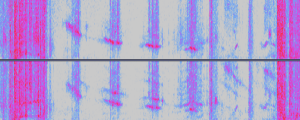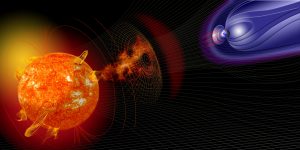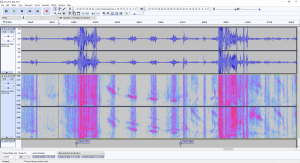18 October 2018
Sounds of a Solar Storm
Posted by Jonathan Griffin
Citizen science study: making measurements audible can advance discovery
By Karin Vergoth
High school students listening to audio tracks of NOAA satellite data have identified the sounds of solar storms buffeting Earth’s magnetic field. The results of a UK-led citizen science project suggest that the approach of converting physical data into sound signals could help NOAA and other scientists make sense of massive amounts of data from satellites and other instruments.

Spectrogram view of the GOES-13 stereo audio file of ultra low frequency wave data Credit: Martin Archer/Queen Mary University of London
“By listening to recordings, these students helped us discover how Earth’s magnetic shield may recover from geomagnetic storms,” says Rob Redmon, a space scientist at NCEI in Boulder, Colorado and co-author of the new study in Space Weather, a journal of the American Geophysical Union.
Ultra-low frequency waves key to space weather
Earth’s magnetic shield, which protects against harmful radiation from the sun and more distant sources, is full of ultra-low frequency (ULF) waves. These waves transfer energy from outside Earth’s magnetic shield to regions inside it. And, they play a key role in creating the impacts of space weather—including geomagnetic storms that can damage power grids, impact GPS, create communications challenges for passenger airlines and mobile telephones, and more. The frequency of those waves ranges from fractions of a millihertz (mHz) up to just 1 hertz (Hz). One thousand mHz equals 1 Hz—a much lower frequency than the range of human hearing.
“Ultra-low frequency waves are too low-pitch for us to hear, but we can make our satellite recordings of them audible by dramatically speeding up their playback with audio software,” says Martin Archer, a scientist at Queen Mary University of London and lead author of the study.

Space weather begins at the sun with an eruption such as a huge burst of light and radiation called a solar flare or a gigantic cloud of solar material called a coronal mass ejection. These immense eruptions can impact Earth by triggering geomagnetic storms, solar radiation storms, and even radio blackouts. Credit: NASA
Sonification: Researchers capitalize on human hearing
So Archer, working with NCEI and university partners, took 10 years of ultra-low frequency wave measurements in Earth’s magnetosphere gathered by NOAA’s GOES-series satellites. The data came from 2007–08 and 2010–17. He converted those measurements into audio files by changing the sampling rate—playing back the raw data files so quickly that they were audible to humans. This process is called sonification. In that data conversion, one year of raw data became six minutes of audio.
“The audio format allows us to get through a lot of data just by listening to it,” Archer says.
One big advantage of converting ULF data into sound is that people are much better at finding a signal in noisy data by hearing it rather than seeing it. So a dataset on a plot might look undistinguished, but converting those data into sound might reveal patterns worth exploring.
“Our ears are better at picking out tones than some of the mathematical techniques we use, particularly when other sounds or lots of noise are also present,” Archer says.
That process might also present interesting opportunities for Redmon and other NCEI scientists tasked with evaluating the quality of data from NOAA instruments.
“Perhaps we could use this method to detect data problems by listening for them,” Redmon says.
One example might be detecting and mitigating artificial magnetic “noise” from the GOES spacecrafts’ reaction wheels, flywheels used primarily by the spacecraft for attitude control. According to Archer, those remnant signals can clearly be heard as very high frequency and modulated tones in GOES-13 and -15 data.
Exploratory citizen science: High school students find signals
Once the researchers converted the GOES satellite data into audio files, they asked high school students to listen to the recordings and find something interesting.
Archer enlisted the help of 12th-year physics students at Eltham Hill School, a girls’ secondary in London. Archer gave students approximately an hour of audio files of the ULF waves, and he also provided off-the-shelf audio editing software and some background on the project. The scientists gave the students broad guidance on how to listen but didn’t tell them exactly what to detect in the sonified data; they wanted to see what the students picked out on their own.

(Top) Waveform view of the GOES-13 summary stereo audio file and (bottom) spectrogram view of the GOES-13 stereo audio file of ULF wave data gathered between September 29 and October 12, 2013. Credit: Martin Archer/Queen Mary University of London
The young people delivered: in the audio files, they heard a big, loud crunch followed by whistling sounds with a pitch that decreased over time. The crunch-and-whistle signal lasted about 5 or 6 seconds in the sound files, meaning over several days in real time. And Archer says the researchers wouldn’t have spotted that event in the data: “These waves could be heard clearly in the audio, but we easily would have missed the signal if we were looking at the time series or spectrogram,” he says.
Sounds after geomagnetic storms
Based on the students’ initial findings, the researchers then set out to explain those detectable changes in the sound of the ULF waves. Because the audio files had a time stamp, Archer and his colleagues could pinpoint exactly when the event happened. Turning to other solar data, they realized that the signals occurred just after a coronal mass ejection or solar storm arrived at Earth. When those storms strike, the resulting disturbance erodes much of the plasma in Earth’s space environment. The changing pitch in the sound files seemed to be caused by plasma refilling the space environment during the recovery phase after the storm.
“The energetic particles caused Earth’s magnetic field to vibrate like a guitar string,” according to Archer.
Previously, these changes in ULF waves were thought to be rare, he says. Using sonified data to detect those changes allowed the researchers to discover just how common these changes are after major coronal mass ejections or solar storms. Now that they have a better understanding of this “recovery” phenomenon, they can investigate the difference between events that create the decreasing pitch sounds and those that do not. Understanding that difference may help them explain what happens during a geomagnetic storm and could improve space weather forecasting.
“Making data audible is uncommon and typically used only by the researchers themselves. Citizen science tends to focus on crowdsourcing data or analysis, unlike our more exploratory method,” Archer says. “This study shows that useful and unexpected scientific results can come from this combined approach.”
NCEI makes audible dataset publicly available
The data used in this study were gathered by NOAA’s GOES satellites and are managed by NCEI scientists. These data, as well as the full audible dataset from the study, are publicly available.
—Karin Vergoth is a science writer for CIRES-NOAA in Boulder, Colorado. This post originally appeared as a press release on the NCEI-NOAA website.










 GeoSpace is a blog on Earth and space science, managed by AGU’s Public Information staff. The blog features posts by AGU writers and guest contributors on all sorts of relevant science topics, but with a focus on new research and geo and space sciences-related stories that are currently in the news.
GeoSpace is a blog on Earth and space science, managed by AGU’s Public Information staff. The blog features posts by AGU writers and guest contributors on all sorts of relevant science topics, but with a focus on new research and geo and space sciences-related stories that are currently in the news.